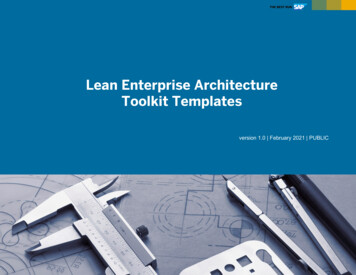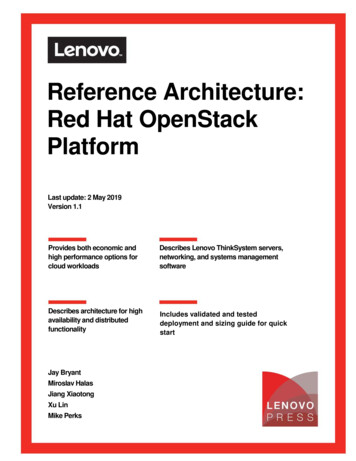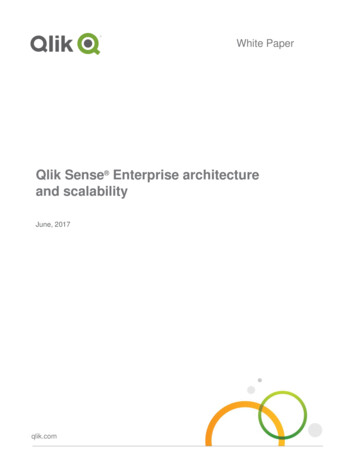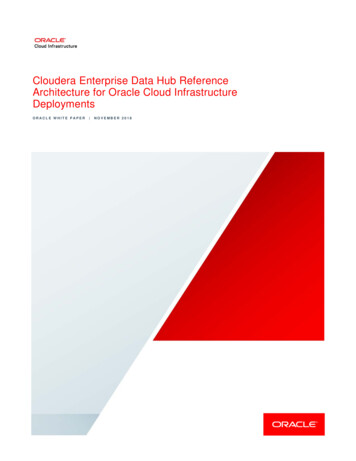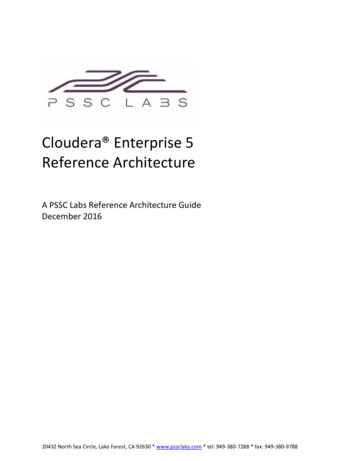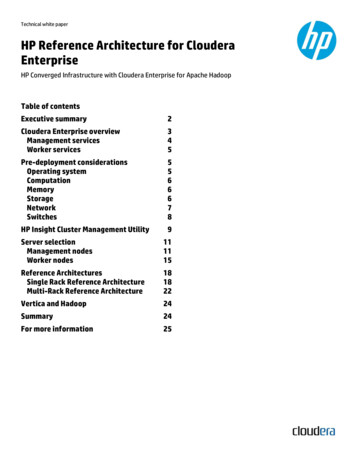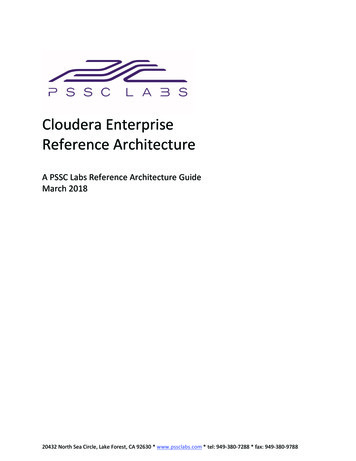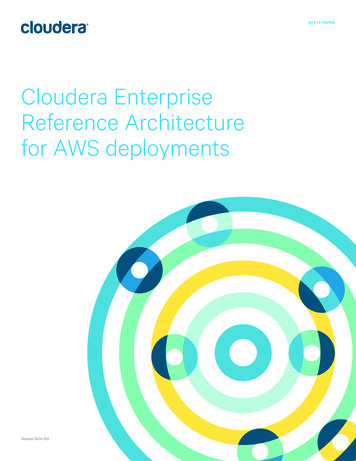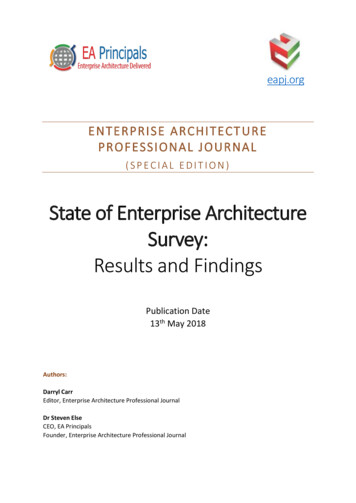
Transcription
eapj.orgE N T E R PR I S E A R C H I T E C T U R EP R O F E S S I ON A L J O U R NA L(SPECIAL EDITION)State of Enterprise ArchitectureSurvey:Results and FindingsPublication Date13th May 2018Authors:Darryl CarrEditor, Enterprise Architecture Professional JournalDr Steven ElseCEO, EA PrincipalsFounder, Enterprise Architecture Professional Journal
1State of Enterprise Architecture SurveyTable of ContentsIntroduction . 2Results . 3Geographical diversity . 3EA Roles. 3Certification. 4Frameworks . 5Architecture Tools . 6Reporting Lines . 7Industries . 7Career Paths . 8Long Form Responses . 9EAPJ Editor’s Findings . 13Survey result observations. 13We have a problem (or two) . 13So where to from here? . 14Editor’s Summary and Conclusion . 15EA Principals CEO and EAPJ Founder’s Findings . 17EA PrincipalsResults and Findingseapj.org
2State of Enterprise Architecture SurveyIntroductionWelcome to this special edition of the Enterprise Architecture Professional Journal.The Enterprise Architecture (EA) discipline is at a crossroads. Originally born from a need tounderstand the burgeoning cost and complexity of IT systems, it has changed substantiallyin execution and perception over its brief 30 year history. Further complicating thisevolution is the astonishing developments over that time in the prevalence and capabilitiesof technology adopted by organizations.This has resulted in an increasing rate of change, with which those responsible for acompany’s future must continually contend. As a result, there is an increase in the potentialfor EA-based approaches to align business and technology strategies, cut through the hypedriven promotion by vendors, and enabling a holistic view to be formed of the enterprise’soperations – including gaps and opportunities.To meet the changing expectation of businesses, the EA discipline must also evolve. In late2017, EA Principals and the Enterprise Architecture Professional Journal conducted a surveyof EA practitioners. The intent was to establish a current state view of the practice,problems and potential future of the EA discipline, in order to better understand how thediscipline is changing, and how practitioners see its relevance now and in the future.The survey contained a series of multiple choice and free text questions, which we haveanalysed and summarised. This report contains the results of that analysis, and representsthe data in two forms:1. Graphical representations, including statistical analysis of content2. Textual summarisation of long-form responsesAcknowledgementThe authors of this report wish to acknowledge the efforts of the respondents. Throughtheir efforts, we are able to gain a clearer, although still incomplete, picture of the status oftoday’s EA discipline, and be better informed as we continue meaningful conversationsregarding its future direction.EA PrincipalsResults and Findingseapj.org
3State of Enterprise Architecture SurveyResultsThe following sections provide statistical and textual summaries of the survey responses,along with the authors’ perceptions of these results.Geographical diversityPractitioners in 19 countries provided survey responses, reflecting the global reach of EnterpriseArchitecture. Results were biased toward the locations of the authors (Australia and the U.S.A.) dueto the promotional activity related to the survey, but have sufficient diversity to cover a range ofcultural considerations.EA RolesAcross the following three options, respondents were asked to give indications of their current andpast experience with the realities of performing an Enterprise Architect role: I have not performed an Enterprise Architecture roleI am currently in an Enterprise Architecture roleI have previously performed an Enterprise Architecture roleResults show that 97% of respondents have current or past hands-on experience in EnterpriseArchitecture, providing assurance that survey responses come from real-world experiences andchallenges.EA PrincipalsResults and Findingseapj.org
4State of Enterprise Architecture SurveyI have previouslyperformed anEnterpriseArchitecture role.50%I am currently in anEnterpriseArchitecture role.47%I have notperformed anEnterpriseArchitecture role.3%CertificationThe subject of certification, and its value to practitioners and their employers, is a matter of ongoingdebate within the global EA community. When asked if respondents have a formal certification, 1 in3 declared that they do not.Given the previous result regarding the hands-on experience in EA roles, it appears that a lack ofcertification is not a barrier to entry in EA roles. Anecdotal evidence in reviewing job advertisementson online job-boards shows a high prevalence of the need for major framework certification,suggesting a disconnect between advertisers/agencies and the experience of practitioners.No37%Yes63%EA PrincipalsResults and Findingseapj.org
5State of Enterprise Architecture SurveyFrameworksThe past 30 years have seen a proliferation, and subsequent consolidation, of EA frameworks. Whenasked what frameworks respondents had used at any point in their career, the following responseswere observed.This result accurately reflects the experience of the authors, in that The Zachman Framework 1 wasprevalent in use in early years as the Enterprise Architecture discipline began, but has beensuperseded by TOGAF 2 in most industries. This transition is backed by significant activity by TheOpen Group (owners of TOGAF) to promote the framework and to generate revenue through itstraining and certification programs. Other frameworks, particularly those aligned to specific industrysegments (e.g. FEAF, DODAF, etc.), do not have an equivalent organization promoting their use.Count of FTOGAFZachman0510152025Additionally, some respondents chose to list ArchiMate 3 as a framework. While this is moreaccurately described as a modelling language/notation, the authors captured the following view ofthe percentage of references made to ArchiMate.Yes19%NoYesNo81%1The Zachman Framework is a registered trademark of Zachman International Inc.TOGAF is a registered trademark of The Open Group.3ArchiMate is a registered trademark of The Open Group.2EA PrincipalsResults and Findingseapj.org
6State of Enterprise Architecture SurveyArchitecture ToolsA proliferation of tools has occurred over the past two decades to support Enterprise Architects intheir attempts to describe current and future state descriptions of organisations, and the transitionbetween those states. This is reflected in the size of the list shown below, which of course is still veryincomplete in terms of what tools are on the marketplace.Distribution across these toolsets is relatively consistent, with the exception of two items: Visio 4 – As a generic drawing tool, Visio has found favour with many architects due to itsbroad availability and familiarity.Sparx Enterprise Architect 5 – Designed as an extensible modelling tool to support a varietyof technology related capabilities, Sparx Enterprise Architect has been extended toincorporate TOGAF and ArchiMate notations. It has gained widespread adoption primarilydue to its very low price-point, making it attractive to a larger range of organization typesand sizes.Count of nfluenceCustomDragon1ErwinEssentialGSA GEARHolocentricIBM SuiteIteraplanIteratecLucidchartMegaMS OfficeNoneOrbus iServerPowerPointProVisionQualiwareRealising SuccessSparx EATrouxVisio0455101520Visio is a registered trademark of Microsoft. All other trademarks are the property of their respective owners.Sparx Enterprise Architect is a registered trademark of Sparx Systems Pty Ltd.EA PrincipalsResults and Findingseapj.org
7State of Enterprise Architecture SurveyReporting LinesThe subject of where an Enterprise Architect should be positioned within an organization has been apoint of significant debate in online EA communities over the years. This is partially fuelled by factorsincluding: Its origins in technology-related effortsA broad perception that its main purpose is to control technological change in anorganisationThe introduction of Business Architecture by some organizations as a distinct discipline,while also forming an integral part of EA capabilitiesWhat can be observed from the results below is that in excess of 75% of respondents haveexperience reporting into IT related management positions. In contrast, only 1 in 7 responses show areporting line that relates to the control of business strategy or operations.FounderCOOCSO2%2% Chief Digital Officer2%EPMO2%CFO 2%2%Chief Architect3%IT Manager5%CIO48%CEO11%CTO11%VP of IT10%IndustriesIt has long been posited that the applicability of an Enterprise Architecture function, and thetransferability of an EA’s skills, across industry boundaries is somewhat universal. To gather relatedevidence, survey respondents were asked which industries they have participated in. The followingchart highlights a broad cross-section of industries, although the numbers weren’t quite as diverseas the authors expected.Of note is the high proportion of respondents who identified IT Services as their main industry. Thishighlights a historical prevalence of EA being offered as a consulting service. This concept is alsoexpanded upon in the analysis of the long-form responses later in the report, and is likely to bemasking some of the industry diversity covered by the respondents.EA PrincipalsResults and Findingseapj.org
8State of Enterprise Architecture SurveyAlso of note is the high percentage of responses for the Financial Services industry, suggesting apotentially longer relationship within that industry with the EA community.Publishing2%Primary t3%2%Financial Services22%Manufacturing3%Government10%IT Services39%Healthcare7%Career PathsThe subject of career progression into Enterprise Architecture roles is a regular discussion pointwithin EA, IT, Management Consulting, Business Analysis and related disciplines. When asked whatprevious architecture-related roles the respondents had performed, Solution Architecture,Information Architecture and Application Architecture occupied nearly 70% of all responses. Manyrespondents cited multiple areas of experiences, highlighting the multi-disciplinary aspect of theEnterprise Architect a/Information19%Security6%EA PrincipalsInfrastructure4%Results and FindingsDomain1%eapj.org
9State of Enterprise Architecture SurveyLong Form ResponsesWe requested a series of long form responses from respondents, too. The sections below show thequestions asked, and a summary of key messages identified in reading the comments received foreach.Question 1 – What metrics do you use to show how Enterprise Architecture adds value to anorganization?This question has been has been discussed at length in online forums, and at EA conferences theworld over. The general consensus tends to point toward measuring the effect of the presence of EAcapabilities and practices on key business performance measures, but other suggestions morealigned to the technical aspects of EA also abound.In the survey, we observed a wide variety of responses -- some expected and some a little different.Here’s a general overview of the key terms used.Business-related Standard business metricsStrategy alignmentRisk identificationBusiness transformation readinessAvailability of informationBenefit realisationTime to marketClient satisfactionProject savingsTechnical debtEA-related Artefact re-use (both physical and virtual)Development of a custom in-house frameworkAwareness of the EA function, and the level of demand for its servicesApproval and dispensation rates for the architecture governance functionSatisfaction surveys for the EA function/teamMaturity assessment resultsPage hits on the architecture siteAlso present in the responses were a number of organizations that do not have metrics for theeffectiveness of the EA capability. In some cases, the reason was due to a low level of maturity, inothers, the absence of metrics was simply due to a lack of desire or mandate to create them.Question 2 – What do you see as the value of Enterprise Architecture?While somewhat related to the first question, this focuses more on the EA’s perception of the valueit offers, rather than the hard metrics used to assess its performance. In some ways, it representsthe selling points, or the promise, of EA. Here are some of the themes emerging from responses: Clarity of, and alignment to, the purpose and vision of the organizationEfficiency and coherence of change deliveryEA PrincipalsResults and Findingseapj.org
10State of Enterprise Architecture Survey Preparation for the onset of disruptive technologyBig picture visualisation and communicationAid decision making capabilities and processesRegulatory alignmentRisk minimisationIncreased competitiveness and differentiationIncreased competitor awarenessOperational efficienciesGovernanceSupport for transformationReduce, or better manage, complexityIntroduce or increase long-term and holistic thinkingStrategy formation and/or alignmentImproved speed to market and adaptabilityImprove internal innovation capabilitiesAlignment of business and ITSupport funding decisionsImprove ROI of change initiativesBuild a foundation for strategy executionIncreased transparencyAssist and/or guide the organisation’s planning activitiesTaken in its entirety, this list represents a substantial impact to the organisation, and involvement ata strategic level. The general focus is on organisational change, and improvements to theorganisation’s ability to do so. Of note was the lack of specific references to technology.Question 3 – As a discipline, where do you see EA heading in the future?Perhaps at the crux of this survey, this question, and the two that follow, attempt to capture therespondents’ thoughts on where the EA discipline needs to change. As stated at the beginning of thisreport, there is a growing perception that EA is at a crossroads. In order to remain relevant, and tocontinue to grow with evolving business and social environments, the discipline must take acustomer-driven view of itself, just as many EA’s recommend for their organisations.Here is a summary of some of the responses given on the perception of the future of EA: More business-alignedAdvisory service to business management and strategy developmentBridging the business and IT divideA catalyst and driver of technological innovation in the business and improvements to theunderlying business modelsA move toward the formal professionalisation of the disciplineEnhancing organisation resilienceBetter understanding of the overall ecosystem to bring about greater interoperabilitybetween organisationsThe future of EA is unpredictableObscurity, unless it evolvesLess ivory tower, and more guidanceIT Strategy developmentEA PrincipalsResults and Findingseapj.org
11State of Enterprise Architecture Survey Dying, due to its high cost and low value/returnSimplification to enable broader adoptionIncorporating organisation design and disciplines such as Design ThinkingBecoming the guardians of change within organisationsBecoming an essential human decision-making capabilitySqueezed into “best practice” systemsReinvention of current practices, models, etc.Less focus on “future state”, and more on “current foundational quality”The business and strategic components will separate and be rebranded as another disciplineThe responses appear to paint a picture of necessity for (or inevitability of) change, with somepredictions suggesting that the discipline will cease to exist if it is unable to evolve quickly. This iscontrasted against suggestions for development of a formal profession, which would requireconsolidation of the definition, function and purpose of Enterprise Architecture.It would appear that the suggested crossroads analogy is indeed correct, with divergence likely if nocoordination occurs.Question 4 – What do you see as an untapped market or unutilized implementation of EnterpriseArchitecture?Traditionally, Enterprise Architecture has been considered the domain of large public and privateorganisations, both from a necessity and an affordability point of view. Over the past few years, agreat deal of material has been written about the concepts inherent in Enterprise Architecture, andhow they might be applied to other organisation types and sizes, along with a number of industriesthat have typically not embraced this role. When asked about areas of hidden opportunity,respondents suggested these areas: Small to medium businesses of all typesTeaching Enterprise Architecture at universitiesFocusing on emerging technologies such as AI, VR and RoboticsDevelopment of reference architectures that can guide software vendors when developingtheir offerings for enterprise useMove toward Enterprise Change Management, covering digital transformation anddisruptionGreater adoption in government to generate efficiencies and standardisation, includingareas such as Policy ArchitectureControlling diversification in the finance industryGreater partnering with Business ArchitectsDeveloping a stronger relationship to the Scaled Agile movementThe use of Enterprise Architecture techniques internally within the large consultanciesGreater cross-discipline collaboration and integrationMore involvement in the social and political arenasTaking a broader, business ecosystem viewAccountability architecture, including topics such as transparencyGreater involvement in strategy formation and organisational design, along with strategyexecutionAgriculture and Primary Industry adoptionMai
The Enterprise Architecture (EA) discipline is at a crossroads. Originally born from a need to understand the burgeoning cost and complexity of IT systems, it has changed substantially . ABACUS Count of References. State of Enterprise Architec

